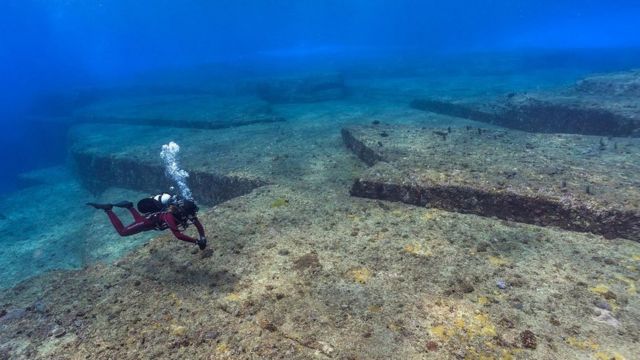Yonaguni Monument, a pyramid-like structure in the Pacific Ocean, is Japan’s westernmost island, which draws its parallel with the lost city of Atlantis. It mystifies scientists, divers, and ancient alien theorists alike. Also commonly referred to as the Yonaguni underwater pyramid, this massive submerged rock formation is at the centre of one of the greatest archaeological mysteries of the modern era.
How did it come into existence? Could it be a natural formation or evidence of an advanced prehistoric civilization? Some even dare to ask—is this proof of a lost alien city beneath the sea?
Let’s delve into the Yonaguni underwater pyramid mystery.
A chance discovery & curiosity
Kihachiro Aratake, a local diver, bumped into something extraordinary—massive, tiered sandstone structures 25 meters below the surface while surveying the seabed for potential dive sites in 1986.
Its symmetrical monolithic appearance immediately drew comparisons to ancient pyramids and megalithic sites like Machu Picchu.
Soon, the world turned its focus to Yonaguni.
The ever-growing curiosity led Japanese marine geologist Professor Masaaki Kimura to spend years, meticulously documenting what he believed to be a man-made structure over 10,000 years old.
According to Kimura, megaliths came during heydays of an ancient civilization—perhaps even pre-dating the Egyptian pyramids—before surging sea levels submerged them during the last Ice Age.
Architectural Marvel Under the Sea
A look at the Yonaguni Monument raises immediate questions. The formation is about 150 meters long and 40 meters wide, resembling a stepped pyramid.
- The Twin Pillars: The presence of towering vertical stones standing like mythical gatekeepers at the entrance gives the feeling of its uncanny resemblance with the Pyramid of Giza.
- The Long Path: A loop road that seems hardly a natural erosion.
- A Star-Shaped Platform: A flat area with sharp geometric patterns attracts curiosity.
- Strange Grand Staircase: Gigantic steps that seem carved with precision elicit wonder.
The similarity with human architecture is uncanny. This factor gives birth to multiple theories.

Science vs Fringe Theories
According to mainstream geologists, the monument is a result of natural tectonic activity and erosion. The Ryukyu Islands are known to be seismically active. According to this theory, Yonaguni is an example of pareidolia, the human tendency to see patterns and intentions where none exist.
However, alien and lost civilization theorists are not ready to buy the idea.
Professor Kimura says he has tools, roads, walls, and even inscriptions at the site. According to him, the monument may be part of the lost continent of Mu or Lemuria—a sunken landmass akin to Atlantis, which is often associated with ancient alien myths. If we go by what Kimura said, this structure could be the oldest human-made structure on Earth, reshaping the understanding of known history.
Is This the Signs of an Alien Outpost?
The Yonaguni site holds an immense fascination for ancient astronaut theorists. Many question if this pyramid is artificial and dates back over 10,000 years, then who could have built it?
Some believe the site might be proof of alien interference. They stress the idea that visitors from the galaxy had left behind advanced technology and architecture before vanishing beneath the waves. Ancient alien theorists draw comparisons between Yonaguni and other famous sites such as:
- The Nazca Lines in Peru
- The underwater structures of Cuba
- The Puma Punku ruins in Bolivia
The point of alien theorists is that aliens did not build these sites for humans, but they displayed to humans how to manipulate massive stone structures with superior techniques we still don’t fully understand.
The Atlantis Link and the Lost Civilizations Theory
Atlantis. Lemuria. Mu. These theories of mythical lost continents have captured the imagination for centuries. Could Yonaguni be a remnant of one of these sunken civilizations?
The lost civilization hypothesis emphasises that before the known rise of modern societies, there may have been a scientifically musch advanced global culture engulfed by a natural disaster.
In case, Yonaguni was once above sea level and part of a bustling city, rising wall of waters after the last Ice Age—around 10,000 years ago—would have totally swallowed it. This timeline creepily matches the estimated age of Plato’s Atlantis.
Skeptics Question
By many it’s an outlandish idea. Geologist Robert Schoch argue that Yonaguni’s structure is purely natural. He substantiate by saying that no artifacts or definitive man-made tools have ever been recovered from the site. He countered claims of inscriptions as misinterpreted natural scratches.
But even Schoch admits: “It’s an amazing formation—natural or not.”
Whether artificial or not, the structure is unique, and its origins remain heavily debated. Even the Japanese government has yet to officially classify it as an archaeological site.
Truth Buried Beneath the Waves?
The Yonaguni underwater pyramid with all claims and counter-claims remains one of the most eye-catching and disputed discoveries of the last century. Whether a marvel of natural erosion or the remnants of a lost, perhaps extraterrestrial civilization, its mystery continues to inspire awe and endless speculation.
The truth about the origins of Yonaguni is shrouded in mystery.
Is there a possibility that Yonaguni is the missing link between ancient myths and modern science fiction?
Is it just another extraordinary geological accident, misinterpreted through the lens of wonder?
At present, the marvelous monument sleeps beneath the waves. It remains a riddle waiting to be decoded.
